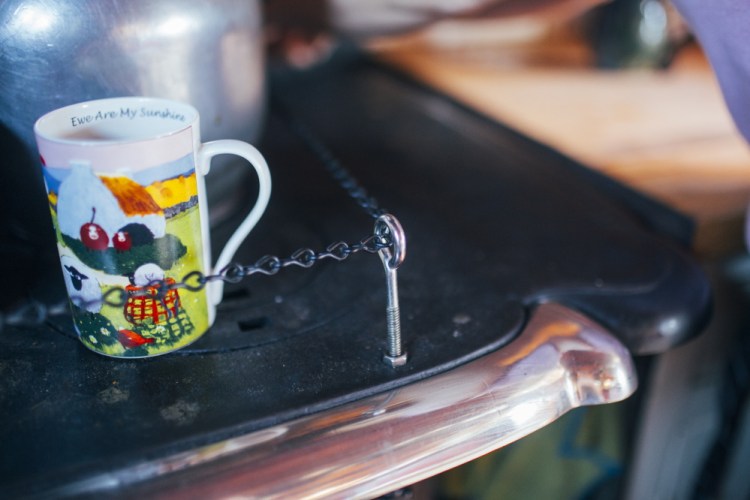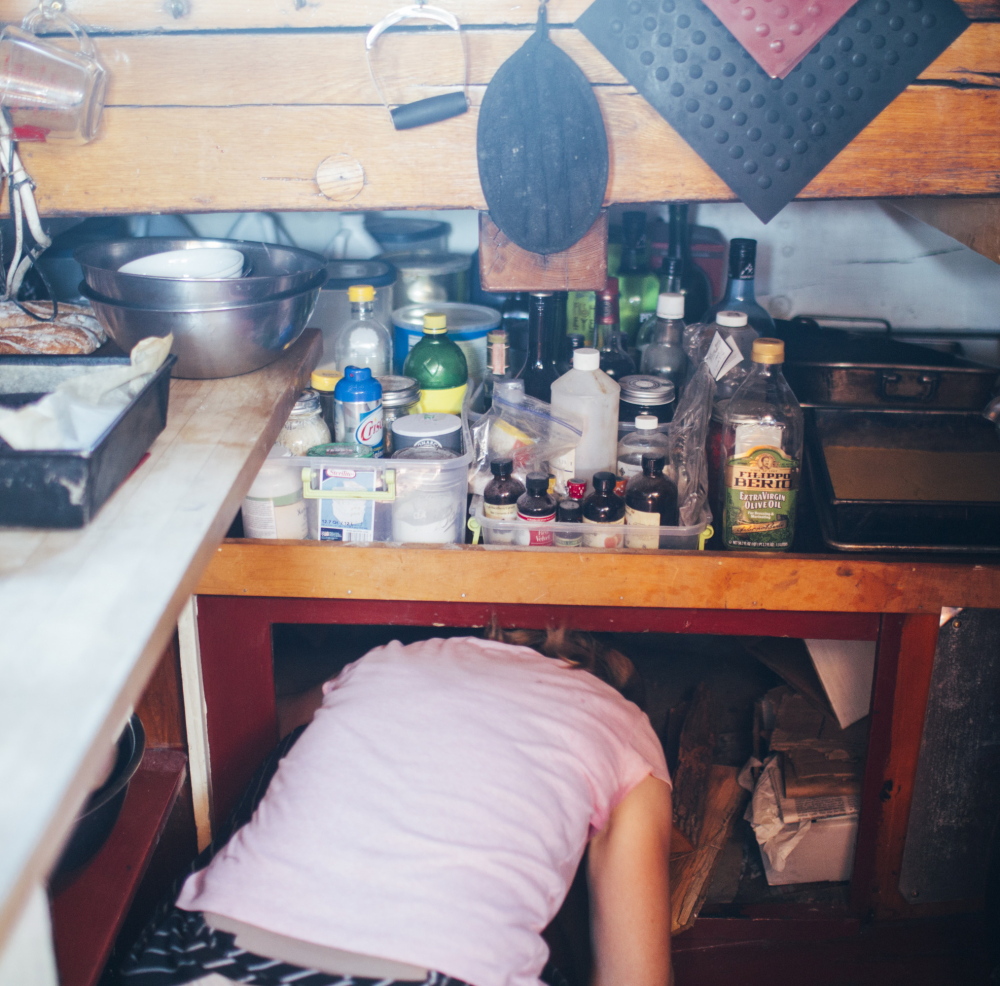It would be wonderful if all of our kitchens looked like the ones in House Beautiful. Right? Or maybe not. I’ve cooked in lavish, marble-countered kitchens with more space than the entire downstairs living area of most homes. And as cook and co-captain on the Schooner J. & E. Riggin, with just a 6-by-8-foot galley (and the woodstove takes up much of that), I’ve also cooked – often – for large groups in teeny-tiny spaces.
In general, I’ll take the small space any day. While sure, sometimes I miss storage space, those big kitchens are a workout. The farther the stove is from the sink is from the refrigerator is from the counter, the more walking the cook needs to do. And let me tell you, it adds up fast.
The key to smart kitchens is not more counter space. It’s not more space of any kind. It’s how to get you and the things you use all the time as close together as possible. Leave the vast spreads of marble to posh design magazines and start thinking smarter about your own space.
On a boat, every available inch of space is used, must be used. There are hooks to hang mugs under the sink, under the stove, under the settees. Every tool, every serving utensil, every ingredient has a storage place. This is not just a throwback to times past when the captain’s word was law and they were obsessive about putting things away. It’s about safety and efficiency.
If you can’t secure it, it can slide off a shelf, out of a cupboard or off the stove, and usually at the most inopportune time. Every storage space not only has a name, it’s equipped with a way to secure the contents when the boat heels 15 degrees. Even the stove has what we affectionately call “the baby gate” – in nautical terms it’s the fiddle – basically a guardrail to keep pots of boiling water and sauces on the stove when the vessel is heeling.
It’s critical on a boat that everything in the kitchen goes back to the same specified location every time. Most well-run kitchens, even on land, operate on the same principle. How often do you search for the can opener or the peeler because one person puts it away in the top drawer and another hangs it on the hook next to the measuring spoons?
This sort of inefficiency in a professional kitchen is the difference between being able to take a much-needed break in the afternoon and having to work straight through.
While your kitchen may not have the challenges that mine does, the same rules of efficiency and organization apply. My rule of thumb is that those tools and ingredients you use several times a day (or a meal) should be located closest to the place you usually stand.
In my galley on the schooner my husband and I operate, I stand and spin in one particular spot. When I’m chopping or kneading bread, the stove is behind me, my pots and pans are at my knees on shelves, the wood for the stove is to the right of my feet in the wood bin, and all of my staple ingredients are above the wood bin.
Those ingredients I use less often are stored on shelves and under settees where guests sit during meals. The refrigerators are on deck, which means that any time we need an ingredient, we need to trek on deck to get it … and then trek on deck to put it away. So no one goes to or from the refrigerator with free hands. It’s all about energy conservation.
And then there’s the work space. My counter space, on which I prepare three meals a day for the 25 or so people sailing with us, is 2 by 3 feet. That’s it. When I tell you organization is the key to every good meal, I’m not messing around.
The only way a good meal ever emerges from my galley is through efficiency, organization, planning and ergonomic work practices.
Some of the tricks I use to maximize my space are: resting the cutting board over the sink, stacking bowls of prepped ingredients, never going anywhere empty handed, using aprons to carry larger loads and ziplocking everything.
As soon as I’m done with a task, I put things away and clear the space before I move on to the next task. I never know when I’ll be called on deck to help sheet in the main or run the yawl boat or respond to a guest’s request, so the makings of a meal or a loaf or a pie cannot be flung all over the galley.
Also, I never know when the wind will shift and suddenly change our lazy downwind sail into a heeling, hard-on-the-wind romp. It happens all the time, and if my entire day’s work is spread out willy-nilly, it could end up on the galley sole (that’s boat talk for floor) in short order. So … I put things away. And you should, too.
While being organized in a home kitchen isn’t nearly the safety issue that it is on a boat, it will make your cooking experiences far more pleasant.
Many of us spend a good deal of time in the kitchen. Even if we don’t love to cook, we still need to get food on the table every day. Making the best of our space and our time will make us happier cooks who can make tastier, timelier meals.
Calamari Fettuccine with Garlic, Parsley and Red Pepper
This recipe was raised to another level by a fantastic food scene in the movie “Chef,” where Jon Favreau makes Pasta Aglio e Olio, a simple yet divine combination of pasta, garlic, parsley, red pepper flakes and lemon.
The addition of calamari makes the dish more grown up and also slightly more complicated, because when cooking calamari attention to detail is key.
Thirty seconds in the life of cooked calamari is the difference between sublime tenderness and chewy rubber bands. Be ready once the calamari goes into the pan.
Serves 4 to 6
1 pound fettuccine
1/4 cup extra-virgin olive oil, plus extra for the pasta
15 cloves garlic, sliced thinly
1/4 teaspoon red pepper flakes
1 pound calamari, cut into 1-inch pieces
1/4 teaspoon kosher salt
2 cups minced parsley, about 1 bunch parsley
4 tablespoons lemon juice
1 cup grated Parmesan cheese
Bring a large pot of salted water to boil over medium-high heat and cook the pasta until al dente, 8 to 10 minutes. One minute before the pasta is done, begin the calamari.
Heat the oil in a large skillet over medium-high heat. Add the garlic and stir until golden brown, about 4 minutes. Add the red pepper, calamari and salt and combine.
The calamari is done when the edges curl and it turns white, about 2 minutes. Remove from heat and add the parsley and lemon juice.
Somewhere in there, drain the pasta and transfer it to a platter. Drizzle with extra-virgin olive oil and sprinkle with half of the Parmesan cheese. Arrange the calamari on top of the pasta.
Serve immediately with the remaining 1/2 cup of Parmesan.
Anne Mahle of Rockland is the co-captain of the Schooner J. & E. Riggin and author of “Sugar and Salt: A Year at Home and at Sea.” She can be reached at:
chefannie@mainewindjammer.com
Send questions/comments to the editors.




Success. Please wait for the page to reload. If the page does not reload within 5 seconds, please refresh the page.
Enter your email and password to access comments.
Hi, to comment on stories you must . This profile is in addition to your subscription and website login.
Already have a commenting profile? .
Invalid username/password.
Please check your email to confirm and complete your registration.
Only subscribers are eligible to post comments. Please subscribe or login first for digital access. Here’s why.
Use the form below to reset your password. When you've submitted your account email, we will send an email with a reset code.